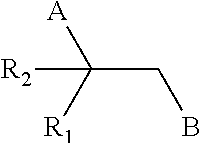Catalyst for synthesizing ethylenimine as well as preparation method and application thereof
- Summary
- Abstract
- Description
- Claims
- Application Information
AI Technical Summary
Benefits of technology
Problems solved by technology
Method used
Image
Examples
example 1
[0033]The reactants are stoichiometrically provided in the forms of oxides, viz. silicon oxide, titanium oxide, and an ammonium phosphate salt, with the weight ratio of 5:80:15 of SiO2 to TiO2 to P2O5.
[0034]10 g of white carbon black was mixed with 160 g of titanium dioxide and 55.7 g of diammonium hydrogen phosphate uniformly. Silica sol was added into the mixture in the amount of 20% of the mass of titanium dioxide. The resulting mixture was kneaded and extruded in the form of strip, then dried at 120° C. for 6 hours, roasted at 350° C. for 6 hours in a muffle, and further roasted for 6 hours with the heating rate of 1° C. / min until the temperature of 650° C. Thus the composite oxide comprising titanium, silicon and phosphorus elements was obtained.
[0035]The composite oxide comprising titanium, silicon and phosphorus elements was cooled and put into the tubular reactor, heated to the temperature of 150° C., then fluoridized for 2 hours with the mixture of HF and N2 in the volume r...
example 2
[0037]The preparation process of the catalyst carrier in Example 2 was the same as that in Example 1, with exception that silicon oxide, titanium oxide, and an ammonium phosphate salt were formulated in the stoichiometric ratio of an amount of the weight ratio of 10:80:10 in the oxides form of SiO2 to TiO2 to P2O5. The resulting catalyst carrier, measured by the low-temperature nitrogen adsorption method, had a specific surface area of 43.2 m2 / g, a pore volume of 0.21 ml / g, and an average pore diameter of 5.8 nm.
[0038]The metal ions were loaded in an amount of 5.3% of the mass of the carrier. The solution the soluble metal salts was prepared in the molar ratio of magnesium ion to iron ion to cesium ion of 8:1:0.1. After the resulting catalyst carrier was immersed in the solution for 8 hours, it was taken out and dried, then roasted in the nitrogen at 350° C. to give the catalyst.
[0039]The resulting catalyst was filled into the reactor with the filling amount of 30 ml, and heated to ...
example 3
[0040]The preparation process of the catalyst carrier in Example 2 was the same as that in Example 1, with exception that silicon oxide, titanium oxide, and an ammonium phosphate salt were stoichiometrically formulated in the weight ratio of 15:80:5 in the oxides form of SiO2 to TiO2 to P2O5. The resulting catalyst carrier, as measured by the low-temperature nitrogen adsorption method, had a specific surface area of 46.8 m2 / g, a pore volume of 0.25 ml / g, and an average pore diameter of 6.1 nm.
[0041]The metal ions were loaded in an amount of 0.5% of the mass of the carrier. The solution of the soluble metal salts was prepared in the molar ratio of magnesium ion to iron ion to cesium ion of 1:1:0.1. After the resulting catalyst carrier was immersed in the solution for 8 hours, it was taken out and dried, then roasted in the air at 650° C. to give the catalyst. The resulting catalyst was filled into the reactor with the filling amount of 30 ml, and heated to the reaction temperature of...
PUM
| Property | Measurement | Unit |
|---|---|---|
| Temperature | aaaaa | aaaaa |
| Temperature | aaaaa | aaaaa |
| Temperature | aaaaa | aaaaa |
Abstract
Description
Claims
Application Information
 Login to View More
Login to View More - Generate Ideas
- Intellectual Property
- Life Sciences
- Materials
- Tech Scout
- Unparalleled Data Quality
- Higher Quality Content
- 60% Fewer Hallucinations
Browse by: Latest US Patents, China's latest patents, Technical Efficacy Thesaurus, Application Domain, Technology Topic, Popular Technical Reports.
© 2025 PatSnap. All rights reserved.Legal|Privacy policy|Modern Slavery Act Transparency Statement|Sitemap|About US| Contact US: help@patsnap.com

